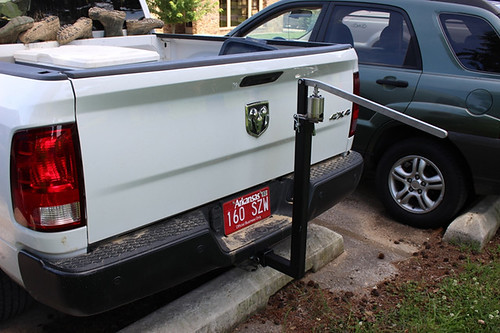Potassium test tool to be on display at upcoming Pine Tree field day via kitchen drawer
By Ryan McGeeney
U of A System Division of Agriculture
Aug. 11, 2017
Fast Facts:
- Kitchen tool inspires soybean sampling device
- Potassium levels key to soybean development
- Pine Tree field day set for Aug. 17
(609 words)
(Download this story in MS Word here.)
MARIANNA, Ark. – As anyone who works with their hands will tell you, the simplest tools can be the hardest to improve upon.
At the University of Arkansas System Division of Agriculture’s Soil Testing Laboratory in Marianna, however, researchers may have done the next best thing, in repurposing a basic kitchen tool concept to help soybean growers divine essential nutrient information about their crops during the growing season.
Nathan Slaton, Professor of Soil Testing and director of the Soil Testing Laboratory, said he and his co-workers have developed an effective method of extracting sap from soybean leaves for the purpose of checking potassium levels at various points in the growth and development cycle.
“That sounds pretty simple, you’d think we’d of figured it out long ago,” Slaton said. “But for most of our history, we’ve been limited by logistics and time.”
Growers curious about a crop’s nutrient status can collect plant tissue samples and mail them to an analytical lab, where the samples will be analyzed for potassium and other essential elements. But the few days between collecting the samples and receiving the lab’s analytical report represent a “dynamic window of opportunity for correcting a nutrient deficiency,” Slaton said.
When grains or fruit begin to develop, they act as a powerful drain on a plant’s available nutrients, and maintaining a critical level of potassium is key to a successful soybean harvest, Slaton said.
“Soybean doesn’t need nitrogen fertilizer because it’s a legume — potassium is probably, here in Arkansas, the most yield-limiting nutrient for soybean on most of our soils,” he said.
A portable tool for measuring potassium has been experimented with since the early 1990’s: the Cardy meter, which can be equipped to measure potassium concentrations or other selected nutrients. Older Cardy meters were about the size of a modern cell phone, but newer models have a slightly different appearance. Extracting the sap and doing the research to interpret the meaning of the potassium concentrations have always been the difficult parts of the process, Slaton said.
“For years, people tried to make the old Cary meters work,” he said. “It wasn’t great.”
Inspiration in the kitchen
Slaton said when he learned of other researchers using hand-held garlic presses to extract petiole sap from potatoes and other fleshy vegetable production systems for analysis with a Cardy meter, a light bulb brightened in his mind.
“If they can do it, then we should be able to do it, too!” Slaton said.
Slaton consulted former Division of Agriculture cotton researcher Derrick Oosterhuis,
who had used a similar device in cotton with limited success, although the woody nature of cotton stems made it somewhat difficult to get enough sap for a reading, Slaton said.
“We played around with that aspect of it last year, using just a hand-held garlic press,” he said. “We had some success with soybean — it wasn’t easy, but we did it. So we actually had a tool built — it fits onto a hitch of a truck, which makes getting the sap out much easier.”
Slaton said the press tool, in combination with available analysis technology, could represent a leap in growers’ ability to recognize and address nutrient deficiencies mid-season.
“We’re confident that we’ll soon have something for farmers, especially those shooting for very high yields, to go out on a weekly basis, and monitor for potassium sufficiency in the soybean plant,” he said. “That’s fairly significant.”
The Pine Tree Field Day is scheduled for Aug. 17 at the Pine Tree Research Station in Colt. See more about this field day at https://uaex.uada.edu/media-resources/news/2017/july2017/07-21-2017-Ark-Pine-Tree-Field-Day.aspx
.
To learn about soil and plant testing in Arkansas, contact your local Cooperative Extension Service agent or visit www.uaex.uada.edu.
About the Division of Agriculture
The University of Arkansas System Division of Agriculture’s mission is to strengthen agriculture, communities, and families by connecting trusted research to the adoption of best practices. Through the Agricultural Experiment Station and the Cooperative Extension Service, the Division of Agriculture conducts research and extension work within the nation’s historic land grant education system.
Pursuant to 7 CFR § 15.3, the University of Arkansas System Division of Agriculture offers all its Extension and Research programs and services (including employment) without regard to race, color, sex, national origin, religion, age, disability, marital or veteran status, genetic information, sexual preference, pregnancy or any other legally protected status, and is an equal opportunity institution.
# # #
Media Contact: Mary Hightower
Dir. of Communication Services
U of A System Division of Agriculture
Cooperative Extension Service
(501) 671-2126
mhightower@uada.edu
Related Links
